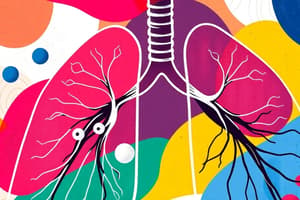Podcast
Questions and Answers
Which of the following best describes the focus of respiratory care pharmacology?
Which of the following best describes the focus of respiratory care pharmacology?
- The application of pharmacology to the treatment of cardiopulmonary diseases and critical care. (correct)
- The preparation and dispensing of medications specifically used in critical care settings.
- The identification of natural sources of drugs used to treat respiratory infections.
- The study of the genetic factors influencing drug response in patients with pulmonary hypertension.
A respiratory therapist is administering a drug obtained from a plant source. Which of the following drugs would most likely fit this description?
A respiratory therapist is administering a drug obtained from a plant source. Which of the following drugs would most likely fit this description?
- Insulin, used to manage blood sugar levels in patients with diabetes.
- Magnesium sulfate, used to relax bronchial smooth muscle.
- Thyroid hormone, used to treat hypothyroidism.
- Eucalyptus oil, used as a decongestant. (correct)
During the drug approval process in the United States, at which phase is the drug first introduced to a small group of human subjects who have the disease the drug is designed to treat?
During the drug approval process in the United States, at which phase is the drug first introduced to a small group of human subjects who have the disease the drug is designed to treat?
- Phase II (correct)
- Phase III
- Phase I
- New Drug Application Phase
Which portion of a prescription contains instructions to the pharmacist on how to prepare the medication?
Which portion of a prescription contains instructions to the pharmacist on how to prepare the medication?
A new bronchodilator is being developed for asthma treatment. What is the MOST important reason for conducting thorough animal studies before proceeding to human trials?
A new bronchodilator is being developed for asthma treatment. What is the MOST important reason for conducting thorough animal studies before proceeding to human trials?
A patient presents with upper airway swelling. Which type of adrenergic medication would be most appropriate for immediate topical decongestion?
A patient presents with upper airway swelling. Which type of adrenergic medication would be most appropriate for immediate topical decongestion?
A patient with COPD is experiencing increased bronchoconstriction. Which of the following medications would be most appropriate to improve ventilatory flow rates?
A patient with COPD is experiencing increased bronchoconstriction. Which of the following medications would be most appropriate to improve ventilatory flow rates?
Which of the following is the primary mode of action for mucoactive agents?
Which of the following is the primary mode of action for mucoactive agents?
A patient is prescribed Montelukast. What is the primary therapeutic goal of this medication?
A patient is prescribed Montelukast. What is the primary therapeutic goal of this medication?
A physician prescribes a medication with the instructions 'qid'. What does this abbreviation indicate to the patient?
A physician prescribes a medication with the instructions 'qid'. What does this abbreviation indicate to the patient?
A patient with cystic fibrosis has a Pseudomonas aeruginosa infection. Which anti-infective agent is most appropriate for this condition?
A patient with cystic fibrosis has a Pseudomonas aeruginosa infection. Which anti-infective agent is most appropriate for this condition?
A patient is prescribed albuterol via inhalation. What is the primary expected therapeutic effect of this medication?
A patient is prescribed albuterol via inhalation. What is the primary expected therapeutic effect of this medication?
Which route of drug administration is described by the abbreviation 'po'?
Which route of drug administration is described by the abbreviation 'po'?
A newborn is diagnosed with Respiratory Distress Syndrome (RDS). Which of the following medications is indicated to improve lung compliance?
A newborn is diagnosed with Respiratory Distress Syndrome (RDS). Which of the following medications is indicated to improve lung compliance?
A patient diagnosed with pulmonary hypertension is prescribed Treprostinil. What is the expected outcome of this treatment?
A patient diagnosed with pulmonary hypertension is prescribed Treprostinil. What is the expected outcome of this treatment?
A respiratory therapist is administering an aerosolized medication. What is a key advantage of delivering drugs via this route compared to oral administration?
A respiratory therapist is administering an aerosolized medication. What is a key advantage of delivering drugs via this route compared to oral administration?
Which medication requires direct instillation into the trachea?
Which medication requires direct instillation into the trachea?
A patient has a prescription with a generic substitution allowed. What does this indicate about the dispensed medication?
A patient has a prescription with a generic substitution allowed. What does this indicate about the dispensed medication?
What does the abbrevation 'prn' written on a prescription mean to the patient?
What does the abbrevation 'prn' written on a prescription mean to the patient?
A patient with COPD is prescribed an adrenergic agent via inhalation. What is the expected outcome of this medication?
A patient with COPD is prescribed an adrenergic agent via inhalation. What is the expected outcome of this medication?
A patient is prescribed a medication with instructions to take it 'qod'. How frequently should the patient take this medication?
A patient is prescribed a medication with instructions to take it 'qod'. How frequently should the patient take this medication?
Flashcards
Drugs
Drugs
Any chemical that alters an organism's functions or processes.
Pharmacology
Pharmacology
The study of drugs, including their origins, properties, and interactions with living organisms.
Respiratory Care Pharmacology
Respiratory Care Pharmacology
Application of pharmacology to cardiopulmonary disease and critical care.
Therapeutics
Therapeutics
Signup and view all the flashcards
Toxicology
Toxicology
Signup and view all the flashcards
Over-the-counter drugs
Over-the-counter drugs
Signup and view all the flashcards
Generic substitution
Generic substitution
Signup and view all the flashcards
"q" in prescriptions means..
"q" in prescriptions means..
Signup and view all the flashcards
"po" in prescriptions means...
"po" in prescriptions means...
Signup and view all the flashcards
"prn" in prescriptions means...
"prn" in prescriptions means...
Signup and view all the flashcards
Advantages of aerosolized agents
Advantages of aerosolized agents
Signup and view all the flashcards
β-Adrenergic Agents
β-Adrenergic Agents
Signup and view all the flashcards
Conditions treated with β-Adrenergic agents
Conditions treated with β-Adrenergic agents
Signup and view all the flashcards
α-Adrenergic Drugs
α-Adrenergic Drugs
Signup and view all the flashcards
Anticholinergic Agents
Anticholinergic Agents
Signup and view all the flashcards
Mucoactive Agents
Mucoactive Agents
Signup and view all the flashcards
Antiasthmatic Agents
Antiasthmatic Agents
Signup and view all the flashcards
Anti-infective Agents
Anti-infective Agents
Signup and view all the flashcards
Exogenous Surfactants
Exogenous Surfactants
Signup and view all the flashcards
Prostacyclin Analogs
Prostacyclin Analogs
Signup and view all the flashcards
Racemic Epinephrine
Racemic Epinephrine
Signup and view all the flashcards
Study Notes
- Rau's Chapter 1 focuses on pharmacology in respiratory care.
Pharmacology and the Study of Drugs
- Drugs are chemicals altering an organism's functions or processes.
- Pharmacology studies drugs (chemicals), including their origins, properties, and interactions within living organisms.
- Respiratory Care Pharmacology applies pharmacology to cardiopulmonary disease and critical care.
- Pharmacy involves the preparation and dispensing of drugs.
- Pharmacognosy identifies the sources of drugs.
- Pharmacogenetics studies the interrelationship of genetic differences and effects.
- Therapeutics is the art of treating disease with drugs.
- Toxicology studies toxic substances and their pharmacologic action.
Naming Drugs
- Drugs have various names, including:
- Chemical name
- Code name
- Generic name
- Official name
- Trade (Brand) name
Sources of Drugs
- Drugs can be derived from:
- Animals, such as thyroid hormone, insulin, and pancreatic dornase
- Plants, such as khellin, atropine, digitalis, reserpine, eucalyptus oil, and anise
- Minerals, such as copper sulfate, magnesium sulfate, and mineral oil
Process of Drug Approval in the United States
- The process involves:
- Chemical isolation and identification
- Animal studies
- Investigational New Drug approval, including Phase I, Phase II, and Phase III trials
- New Drug Application
- FDA new drug classification system
- Approval of orphan drugs
The Prescription
- Prescriptions consist of several parts:
- Patient name, address, and date
- Rx symbol
- Inscription: medication names / dosage
- Subscription: the amount of medication to be given
- Sig: directions for the patient
- Prescriber's name
- Over-the-counter drugs do not require a prescription.
- Generic substitution in prescriptions involves using any manufacturer's version of the prescribed drug, which is generally less expensive.
Abbreviations Used in Prescriptions
- q: every
- qh: every hour
- qid: four times daily
- qod: every other day
- qd: every day
- q2h: every 2 hours
- q3h: every 3 hours
- q4h: every 4 hours
- po: per os (by mouth)
- prn: as needed
- IM: intramuscular
- IV: intravenous
- tid: three times daily
Respiratory Care Pharmacology Overview
- Involves aerosolized agents given by inhalation, which has five advantages.
- Includes related drug groups:
- Anti-infective agents
- Neuromuscular blocking agents
- Central nervous system agents
- Antiarrhythmic agents
- Antihypertensive and antianginal agents
- Anticoagulant and thrombolytic agents
- Diuretics
Advantages of Aerosolized Agents Given by Inhalation
- Smaller doses are used compared to systemic administration.
- Fewer and less severe side effects compared to oral or parenteral delivery.
- Rapid onset of action.
- Targeted drug delivery to the respiratory system with lower systemic bioavailability.
- Painless and relatively safe inhalation of aerosol drugs, with convenience depending on the delivery device used.
Adrenergic Agents
-
Beta-Adrenergic agents: cause relaxation of bronchial smooth muscle and bronchodilation, reducing airway resistance (Raw) and improving ventilatory flow rates in airway obstruction resulting from COPD, asthma, cystic fibrosis (CF), and acute bronchitis. Examples include Albuterol, Arformoterol, Formoterol, Levalbuterol, and Salmeterol.
-
Alpha-Adrenergic agents: used for topical vasoconstriction and decongestion to treat upper airway swelling; Racemic Epinephrine is an example.
-
Anticholinergic Agents: relax cholinergically induced bronchoconstriction to improve ventilatory flow rates in COPD and asthma. Examples include Glycopyrrolate bromide, Ipratropium Bromide, and Tiotropium Bromide.
Mucoactive Agents
- Modify the properties of respiratory tract mucus, reducing viscosity and promoting clearance of secretions.
- Examples are Acetylcysteine, Dornase Alfa, Mannitol, and Hyperosmolar Saline.
Antiasthmatic Agents
- Prevent the onset and development of the asthmatic response by inhibiting chemical mediators of inflammation.
- Examples include Cromolyn Sodium, Montelukast, and Omalizumab.
Anti-infective Agents
- Inhibit or eradicate specific infective agents.
- Examples are Ribavirin for RSV and TOBI for Pseudomonas Aeruginosa in CF or Influenza A and B.
Exogenous Surfactants
- Approved for clinical use via direct intratracheal instillation to restore more normal lung compliance in RDS of newborns.
- Beractant, Calfactant, Poractant Alfa, and Lucinactant are examples.
Prostacyclin Analogs
- Clinically indicated to treat pulmonary hypertension by decreasing shortness of breath and increasing walking distance.
- Examples: Iloprost, Treprostinil
Studying That Suits You
Use AI to generate personalized quizzes and flashcards to suit your learning preferences.



